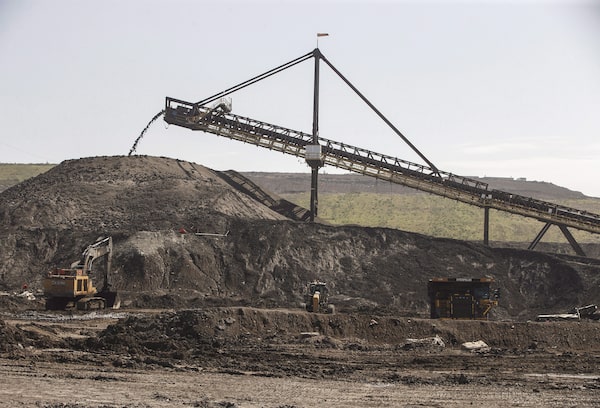
A hopper moves dirt in Suncor's Millennium mine in the oilsands in Fort McMurray, Alta., on June 13, 2017. Canada's biggest oilsands producers are looking to Indigenous communities to take a financial interest in a massive proposed carbon capture and storage facility near Cold Lake, Alta.JASON FRANSON/The Canadian Press
The group behind a massive emissions reduction project in Alberta’s oil sands is in talks with Indigenous communities to have them take an economic interest in a 400-kilometre pipeline that would transport carbon captured from oil sands facilities to an underground hub near Cold Lake.
The Pathways Alliance, a consortium of Canada’s largest oil sands producers, has for years been planning the project as a key part of its pledge to reduce greenhouse gas emissions from production to net zero by 2050. The idea is to eventually link more than 20 facilities with a carbon storage hub in northeast Alberta via one of the largest such projects in the world, reducing net carbon dioxide emissions by about 10 megatonnes a year by 2030.
Informal talks with local Indigenous communities have been part of early project planning, but Pathways president Kendall Dilling said the discourse has evolved from conceptual discussions early on to the next phase of formal dialogue now that the technical and engineering details have been ironed out.
Economic participation is an important part of those discussions, Mr. Dilling said, and Pathways members would like to establish Indigenous equity stakes or other forms of material and financial participation in the project.
“It’s ultimately up to them, but we certainly put the offer on the table. If they want to participate in that level, we’re open to that,” he told The Globe and Mail at the 24th World Petroleum Congress in Calgary.
Pathways members include Cenovus Energy Inc. CVE-T, Canadian Natural Resources Ltd. CNQ-T, ConocoPhillips Canada Co. COP-N, Imperial Oil Ltd. IMO-T, MEG Energy Corp. MEG-T and Suncor Energy Inc. SU-T
Formal consultations have only just begun, though some communities have already raised concerns about the Pathways Carbon Capture and Storage (CCS) project. That includes Cold Lake First Nations, close to the final planned CO2 hub.
“It just seems like they’re ramming it down our throat,” Chief Kelsey Jacko told CBC News last week. His community is particularly worried about the long-term consequences of injecting carbon dioxide into pore space below the ground, and the possibility of leakage.
More than 20 Indigenous communities are located along the proposed transportation and storage network corridor.
Economic participation by Indigenous groups has rapidly become more common in large natural resource and infrastructure projects in Canada and other countries, such as Australia.
Andrew Swart, managing partner of energy resources and industrials at Deloitte Canada, a consulting firm, says it’s a trend that will likely build momentum.
“I think we have a real opportunity at this point in the energy transition as we build out the next generation of energy infrastructure – whether it’s hydrogen, renewables, CCS – to be shifting that and actually drive real participation of Indigenous communities,” he said in an interview Tuesday.
“And so I think that requires a shift in mindset, where Indigenous communities are not seen as stakeholders, but are actually seen as real partners.”
The rubber is hitting the road for the foundational Pathways project, Mr. Dilling said. As members plan for procurements starting early in 2024, delays to major project milestones could put the 2030 target – and net zero by 2050 – in jeopardy.
“We’re already on critical path. We don’t have slippage time in the schedule,” he said.
Delays could come from myriad directions, including the rollout of a federal investment tax credit to support capital investments, or Alberta’s planned carbon capture support program, based on an existing grant for petrochemical facilities.
Alberta Premier Danielle Smith, however, said this week she would like to get the province’s new CCS program finalized before November when she heads to COP28, the United Nations climate convention.
Pathways is also in the midst of negotiating federal contracts for difference, which would guarantee a minimum value for carbon credits to be generated under Canada’s industrial carbon pricing system.
“At this point we are optimistic that there’s light at the end of the tunnel,” Mr. Dilling said.
One positive for the project is that it lies within a single provincial jurisdiction that already has a well-established CCS regulatory framework in place.
“That doesn’t mean that it’s easy and everyone sings Kumbaya together, but when ultimately everybody’s trying to address the climate imperative and reduce emissions and we’re coming to the table saying we can reduce 12 million tonnes a year with this project, people want to get to a ‘Yes,’ ” Mr. Dilling said.
Even if there are delays because of procurement, or hiccups in fine-tuning regulations, he believes that the most important thing is to show real progress.
“I don’t personally think 2030 versus 2031 matters a lot in the big scheme of things. What we can’t do is say, ‘We’ve got a net-zero 2050 plan, and we’re gonna do it all in the 2040s.’ It’s just not feasible,” he said.